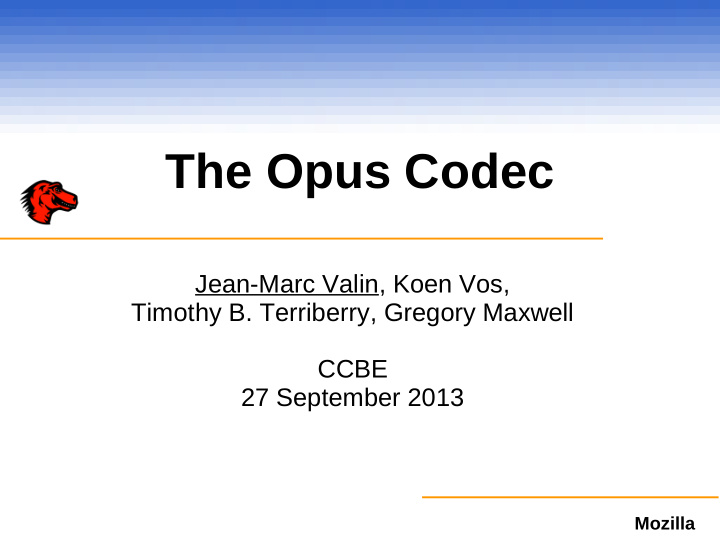



The Opus Codec Jean-Marc Valin, Koen Vos, Timothy B. Terriberry, Gregory Maxwell CCBE 27 September 2013 Mozilla
What is Opus? ● New highly-flexible speech and audio codec – Works for most audio applications ● Completely free – Royalty-free licensing – Open-source implementation ● IETF RFC 6716 (Sep. 2012) Mozilla
Why a New Audio Codec? http://xkcd.com/927/ http://imgs.xkcd.com/comics/standards.png Mozilla
Why Should Broadcasters Care? ● Ultra-low delay ● Adaptability to varying network conditions ● Best-in-class performance within a wide range of bitrates ● No licensing costs ● No incompatible flavours Mozilla
Applications and Standards (2010) Application Codec VoIP with PSTN AMR-NB Wideband VoIP/videoconference AMR-WB High-quality videoconference G.719 Low-bitrate music streaming HE-AAC High-quality music streaming AAC-LC Low-delay broadcast AAC-ELD Network music performance Mozilla
Applications and Standards (2013) Application Codec VoIP with PSTN Opus Wideband VoIP/videoconference Opus High-quality videoconference Opus Low-bitrate music streaming Opus High-quality music streaming Opus Low-delay broadcast Opus Network music performance Opus Mozilla
Features ● Highly flexible – Bit-rates from 6 kb/s to 510 kb/s – Narrowband (8 kHz) to fullband (48 kHz) – Frame sizes from 2.5 ms to 60 ms – Speech and music support – Mono and stereo – Flexible rate control – Flexible complexity ● All changeable dynamically, signaled within the bitstream Mozilla
Rate Control ● Opus supports true CBR – Every packet has the same number of bytes – No bit reservoir => no extra delay – Quality not as good as VBR ● Constrained VBR – Total variation within 1 frame of CBR (same as bit reservoir) – Bounded delay, better transients, etc. ● True VBR – Open loop: calibrated to a large corpus – Gets the most benefit from new encoder improvements ● Bitrate cap possible for both VBR modes Mozilla
Opus Design ● SILK: Based on voice codec from Skype ● CELT: MDCT codec from Xiph.Org Encoder Decoder D CELT CELT In + Out bit-stream ↓ SILK SILK ↑ MUX DEMUX 48 kHz 8-16 kHz 8-16 kHz 48 kHz ● Better than sum of its parts (Hybrid mode, seamless mode switching) Mozilla
SILK Technology ● Originally used in Skype ● Based on linear prediction (LPC) ● Very good at narrowband and wideband speech up to ~32 kb/s ● Not very good on music ● Heavily modified to integrate with Opus Mozilla
SILK Technology ● Based on Noise Feedback Coding rather than Analysis-by-Synthesis ● Analysis/synthesis mismatch to de- emphasize spectral valleys – Replaces post-filters ● Variable-rate coding Mozilla
CELT Technology ● “Constrained-Energy Lapped Transform” – Psychoacoustics built into the format – Harder to write a bad encoder ● Works on speech and music ● Most efficient on fullband audio (48 kHz) ● Less efficient on low bitrate speech Mozilla
CELT Technology ● MDCT with low-overlap window ● Code band energy separately from spectrum “details” – Preserves the energy in each critical band ● Implicit masking curve defined by the format – No need to code scalefactors Mozilla
CELT Stereo Coupling ● Code separate energy for each channel – Prevents cross-talk ● Converts to mid-side after normalization – Mid and side coded separately with their relative energy conserved – Prevents stereo unmasking ● Intensity stereo – Discards side past a certain frequency Mozilla
Google Listening Tests Wideband/ Fullband Mozilla
HydrogenAudio Results 64 kbit/s Mozilla
Cascading Tests (AES 135) 5 cascadings Bitrate = 128 kbit/s Mozilla
Adoption ● Broadcast – Tieline, Mayah, Harris Broadcast – CBS, ABC, NBC, NPR, Fox, Cumulus, ... ● Distribution – Magnatune music store – StreamGuys CDN ● VoIP and videoconference – Jitsi, Meetecho, CounterPath, Mumble, Teamspeak, ... – Mandatory-to-implement for WebRTC Mozilla
Adoption ● HTTP streaming – Firefox 18+ (incl. FFOS), Chrome, Opera – Lots of other players: ● FFMpeg, GStreamer, VLC, Foobar2k, Winamp (with a plugin), Amarok, xmms2, etc. – Icecast 2.4-beta1 added Opus support ● Examples: – http://dir.xiph.org/by_format/Opus – http://www.absoluteradio.co.uk/listen/labs.html Mozilla
Roadmap Mozilla
libopus 1.1 ● Beta released in July, full release “soon” – https://people.xiph.org/~xiphmont/demo/opus/demo3.shtml ● First release with True VBR – Tonality estimation – Better dynamic allocation ● Improves on the built-in psychoacoustics – Temporal VBR (discovered by accident!) ● Automatic speech/music detection – Optional delayed decision (better high-latency performance) Mozilla
libopus 1.1 (cotd.) ● Better surround encoding – Better API (knows which channel is which) – Better LFE encoding – Inter-channel masking ● Major ARM performance gains: – 40% decoder CPU reduction – 27% encoder CPU reduction (33% with Neon) Mozilla
Standards ● RTP (draft-ietf-payload-opus) – Hopefully WGLC soon ● Ogg (draft-ietf-codec-oggopus) – Maybe WGLC soon? ● WebM (Matroska) – Opus paired with VP9 for next RF video format ● Used by YouTube – Spec’d at https://wiki.xiph.org/MatroskaOpus ● Implementations underway ● Minor RFC 6716 revisions (draft-valin-codec-opus-update) – 3 minor bug-fixes to the reference implementation – Feedback at codec@ietf.org welcomed! Mozilla
Opus in RTP ● Very simple: 1 RTP payload == 1 Opus packet – From 2.5 ms to 120 ms audio ● Packets decodable with no OOB signaling – No negotiation failure, always opus/48000/2 – All SDP parameters are informative – Mono/stereo, bitrate, audio bandwidth, frame size, mode, etc., signaled in band – Receiver decodes all of these transparently ● Encoder and decoder can run at different rates Mozilla
Opus in Ogg ● Includes surround support, up to 255 channels ● Similar to RTP mapping – Header is informative (except surround) Mozilla
Resources ● Website: http://opus-codec.org ● Mailing list: opus@xiph.org ● IRC: #opus on irc.freenode.net ● Git repository: git://git.opus-codec.org/opus.git Questions? Mozilla
Recommend
More recommend